Article's Content
The success of a startup does not just depend on the business model it chooses in its early days. New adoptions, strategies, teams and more all come together at the right time to drive companies’ successes.
To achieve optimal success, Netflix had to move from being a content distributor to both a creator and distributor. Salesforce had to change from a pure subscription model and operate on a pay-as-you-go subscription-based business model. And so, for each of these companies, these decisions brought unprecedented success and completely changed how the world viewed them.
For Coursera, it was the move from a standard B2C company to a combined B2C and B2B model. Coursera’s initial mission was to give everyone access to top-quality educational content created by prestigious universities. In plain English, it was a B2C model.
But over the years, Coursera’s B2B model has given them a unique angle to sell their services, which has completely changed the face of Coursera.
This article shows you how embracing a B2B business model has helped Coursera grow. Let’s roll.
Want to Steal Coursera’s Segmenting Strategy? Download this checklist!
By downloading this resource, you’ll also start receiving a few emails per week on B2B growth and content marketing
Keeping the Balance Between B2C And B2B Model
MOOC (Massive Open Online Courses) companies generate revenue by selling add-ons (course certification, diploma, etc.) directly to learners.
It’s a B2C model or a “business to learner” model, if you will. However, this model has not prevented them from adopting a B2B model–in fact, they combine both.
Starting with the basic B2C business model
The mission of the two co-founders of Coursera, Andrew Ng and Daphne Koller, was to provide access to the highest-quality educational content from respected and prestigious universities to learners worldwide. The Coursera platform thus served as a direct way for learners to access courses.
The B2C business model has resulted in millions of learners and has proven to be very effective in this sense. However, under this model, users only took the free courses. And Coursera only made money through the verified certificate, also known as the Signature Track, and through the introduction of specialization courses.
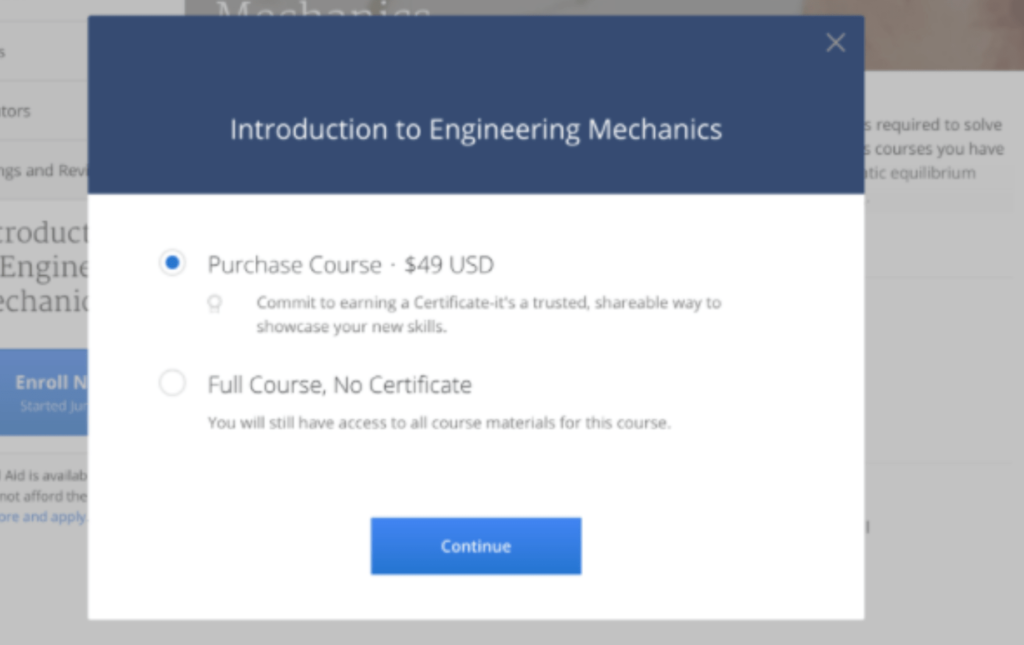
When you look at Coursera’s revenues from the perspective of a company that shares 6-15% of its total revenues with universities and invests 20% of its gross profits in its courses, it is clear that the B2C model was not their path to profitability.
Coursera then had to figure out a new way to increase its revenue while preserving its existing business model, and avoid alienating all the free learners and universities it partnered with.
Transitioning to a B2B business model to drive growth
Don’t get it wrong, Coursera stays true to its B2C business model and continues to appeal to individual learners. This vertical generated over $193m in 2020.
But the move to a B2B business model with the introduction of Coursera for Business is undoubtedly one of the most thoughtful decisions Coursera has ever made.
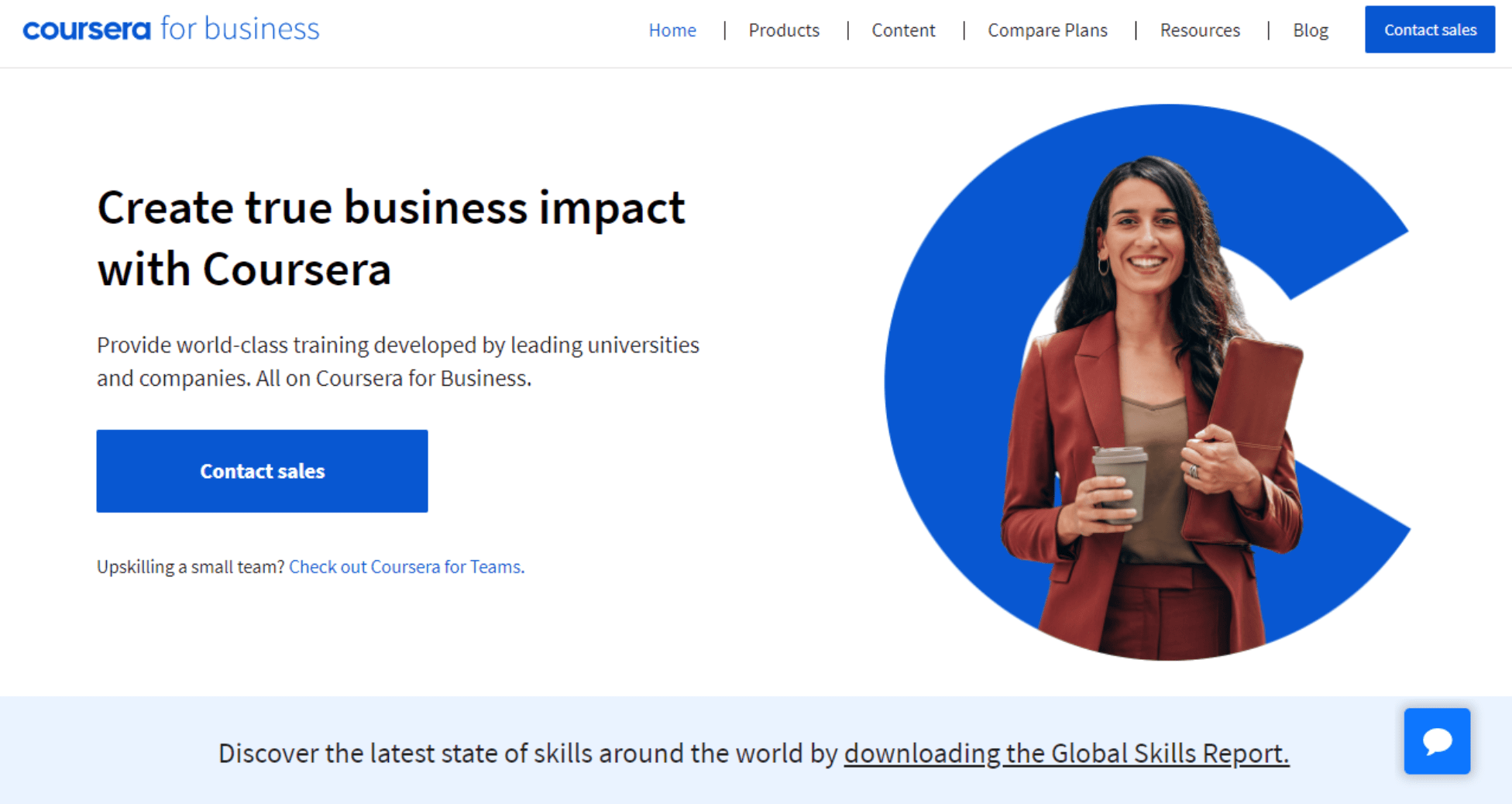
How does this business model differ from the B2C model?
Coursera partners with companies that need training resources to improve their executives’ or staff members’ skills and provides them with the necessary courses.
Technically, it is a kind of university for companies that want to improve the skills of their employees in order to achieve strategic business goals by developing critical skills.
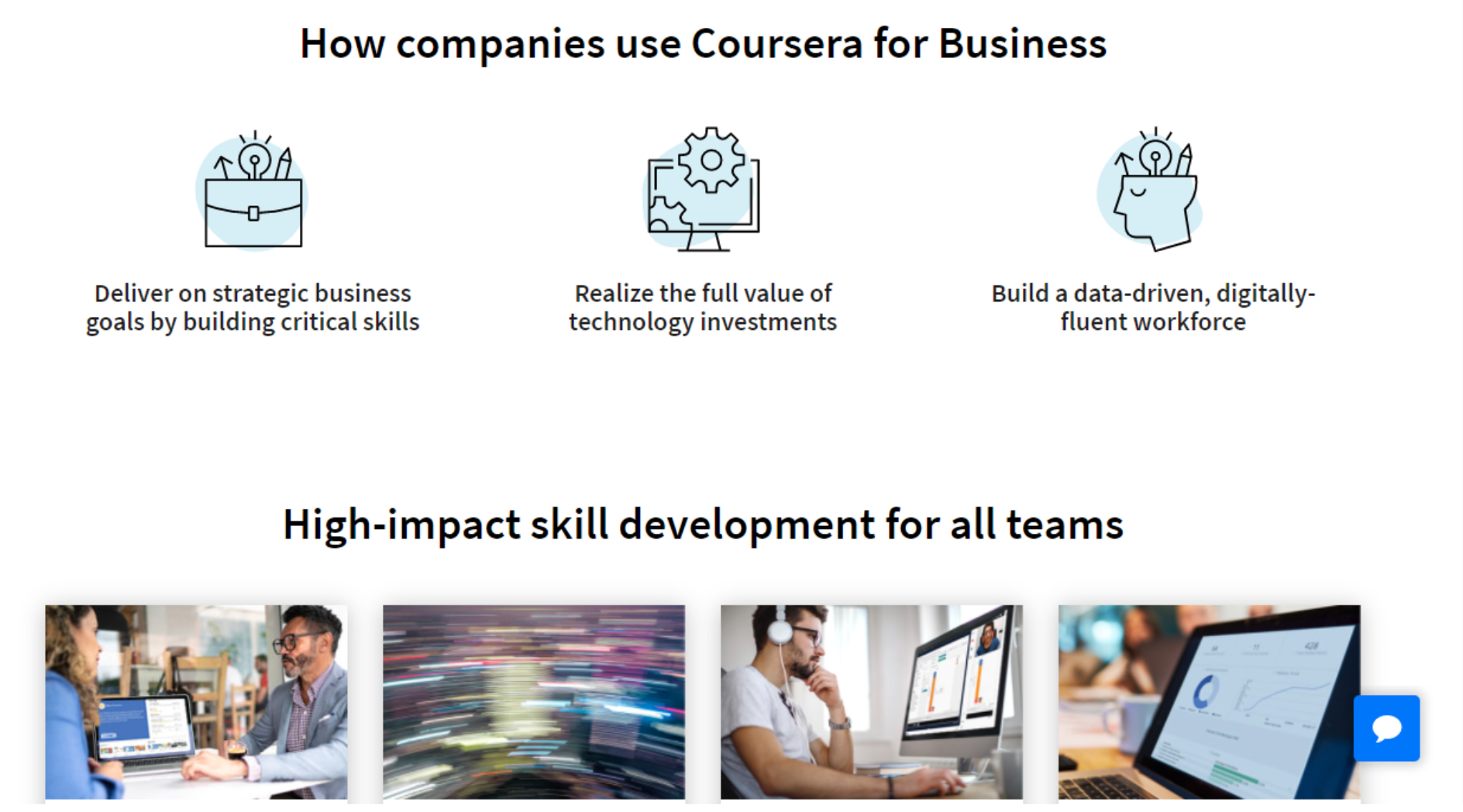
And there is definitely a market for this. More than 50% of companies reported facing a skills shortage globally, including the United States (69%), Italy (47%), and Mexico (52%).
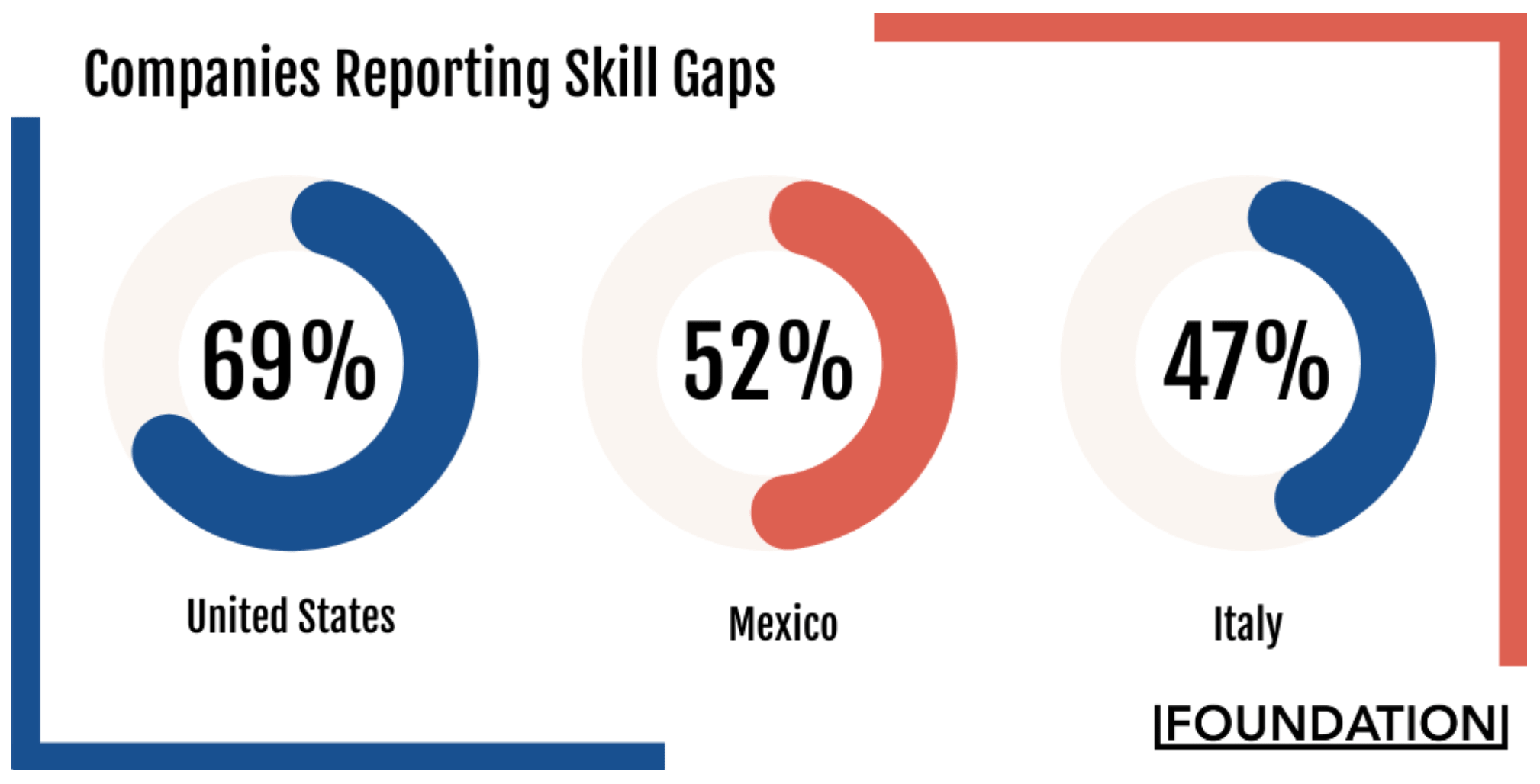
Coursera has identified the global employee skills gap and is taking advantage of it to drive growth.
The B2B business model has proven to be a powerful source of revenue. Currently, Coursera for Business brings in about 1/3 of the company’s annual revenue. That’s about $136 million.

And believe it or not, this is not a random occurrence. Amazon, which also operates on a combined B2B and B2C model, generates 12% (over $12 billion) of its revenue from the B2B vertical.
Here’s what pricing looks like for a single Coursera for Business customer.
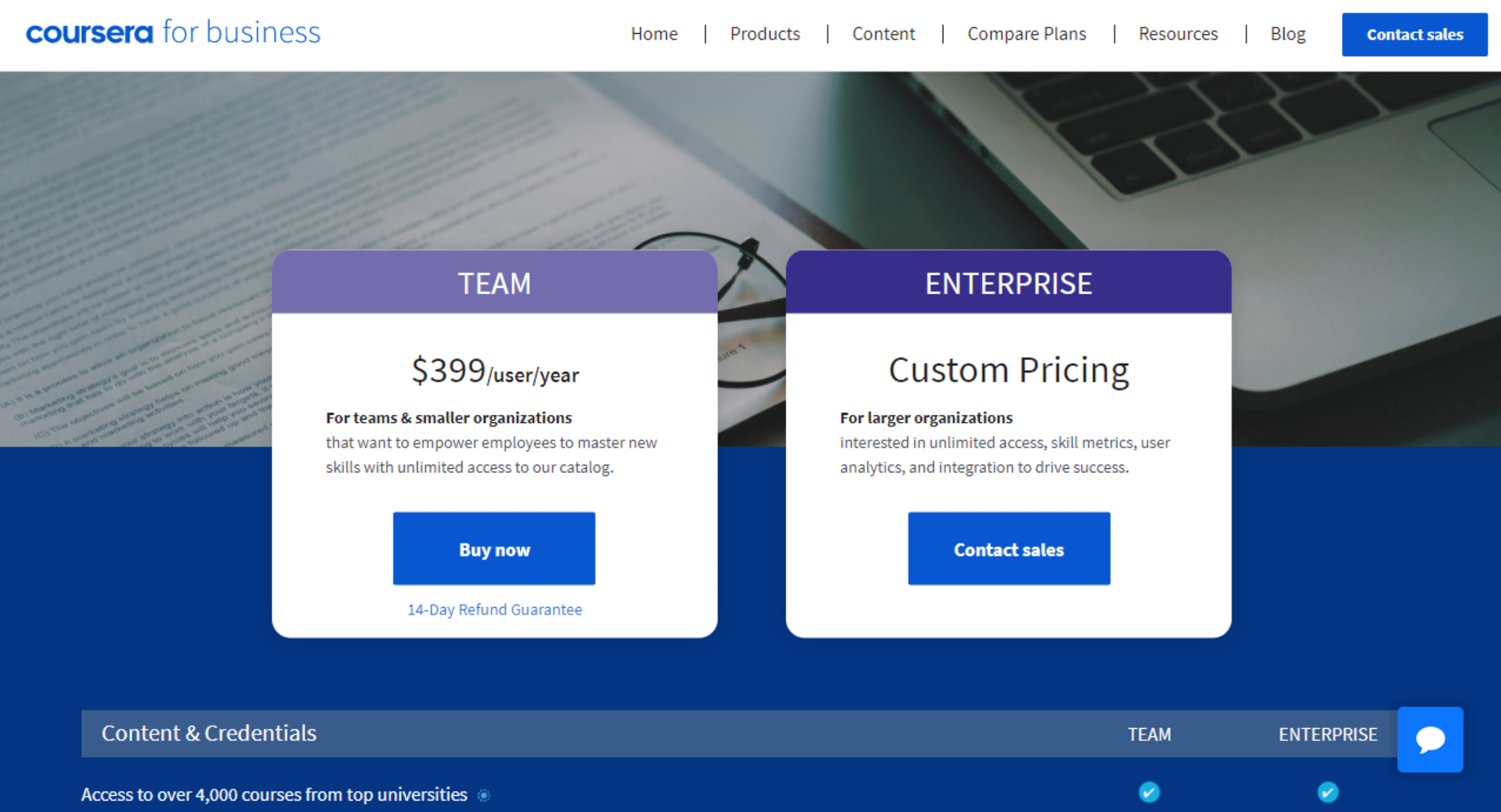
At least 2,300 companies use Coursera for Business, including the pharmaceutical company Novartis, which has enrolled all of its 108,000 employees in Coursera for Business. The Novartis deal alone, at a $400/year/user cost, represents annual revenue of up to $43,000,000.
Juicy, isn’t it?
By now, you might be thinking that Coursera is doing well with both business models, which is true. But if you look at it closely, the line between Coursera’s B2C and B2B business model is very thin, and an imbalance could be very costly to the brand.
So, how do they keep the balance between these two models?
Walking The Line Between B2C and B2B
Coursera has found a way to guarantee steady revenue by offering both B2C and B2B offerings. If you know a thing or two about marketing, you know that’s easier said than done.
Here’s an example. In a B2C context, the buying decision of the average consumer is influenced by many different choices. These types of consumers buy in the same way and through the same types of processes.

On the other hand, on the B2B side, buying experiences are very complex and are influenced by the industry, the type of product, the buying committee, and the size and operation of the company.
And unlike the B2C buyer, the B2B buyer is often not really the buyer, at least not in the traditional sense. He is often a procurement expert whose task is to execute a contract.
Here’s how they did it.
Contrary to what most marketers expect when adopting two different business models, Coursera has not significantly changed its positioning.
The company still defines itself as the global online learning platform that offers access to online courses to “anyone, anywhere.” And more importantly, it still uses one main landing page: Coursera.org.
But on closer inspection, it’s all there. Here’s how it’s structured.
Coursera uses a site structure a la Shopify. They actually use “coursera.org” as the main landing page, or mother landing page if you will, for the B2C side of the business, and “coursera.org/business,” a subdirectory, as the child landing page for the B2B side.
So, the main homepage showcases everything the company does, both from a B2C and B2B perspective, but gives the edge to the B2C side of the business.
Why?
Because, while the B2C vertical generates more revenue with a large number of users, the B2B vertical with only 3,000 users generate over 33 percent of Coursera’s annual revenue. It would therefore sound insane not to put both revenue streams upfront on the landing page.
Now, let’s have a look at the strategy Coursera uses to fuel its B2B model on a platform that is mainly aimed at individuals.
Leaning into B2B Learning
To say that Coursera for Business has a substantial role to play in the future of Coursera is a big understatement.
For example, for all of the fiscal year 2021, Coursera reported expectations for revenue of between $402 million and $410 million. And a third of that revenue, a whopping $136 million+, comes from the Coursera for Business branch.
For some context, Coursera for Business is aimed at companies that plan to train or upskill a small team within their organization or transform the entire business. Think of heavyweights such as Mastercard, Southwest Airlines, Adobe, Google, Facebook, and more.
In an interview, Coursera CEO Jeff Maggioncalda said that the company’s latest impressive results reflect “the growing adoption and impact” of the Coursera [for Business] platform
“Institutions are using Coursera to drive large-scale re-skilling efforts,” Maggioncalda added.
Four Assets Coursera Uses to Convert B2B Buyers
According to a Dun & Bradstreet study, 67% of buyers in the B2B space list “relevant communication” as a primary influence for choosing one solution provider over another.
Translation: if you speak to your B2B prospects the same way you speak to your B2C buyers, you will never close a deal.
As a matter of fact, Coursera understands this and has strategically put in place different assets whose objectives are to get coursera.org/business visitors into their optimized sales pipeline.
Here is a sneak peek inside some of these assets.
B2B messaging
As you already know, brands typically market to their audiences and communicate with them accordingly.
In the case of Coursera for Business, the language used in the platform is all business.
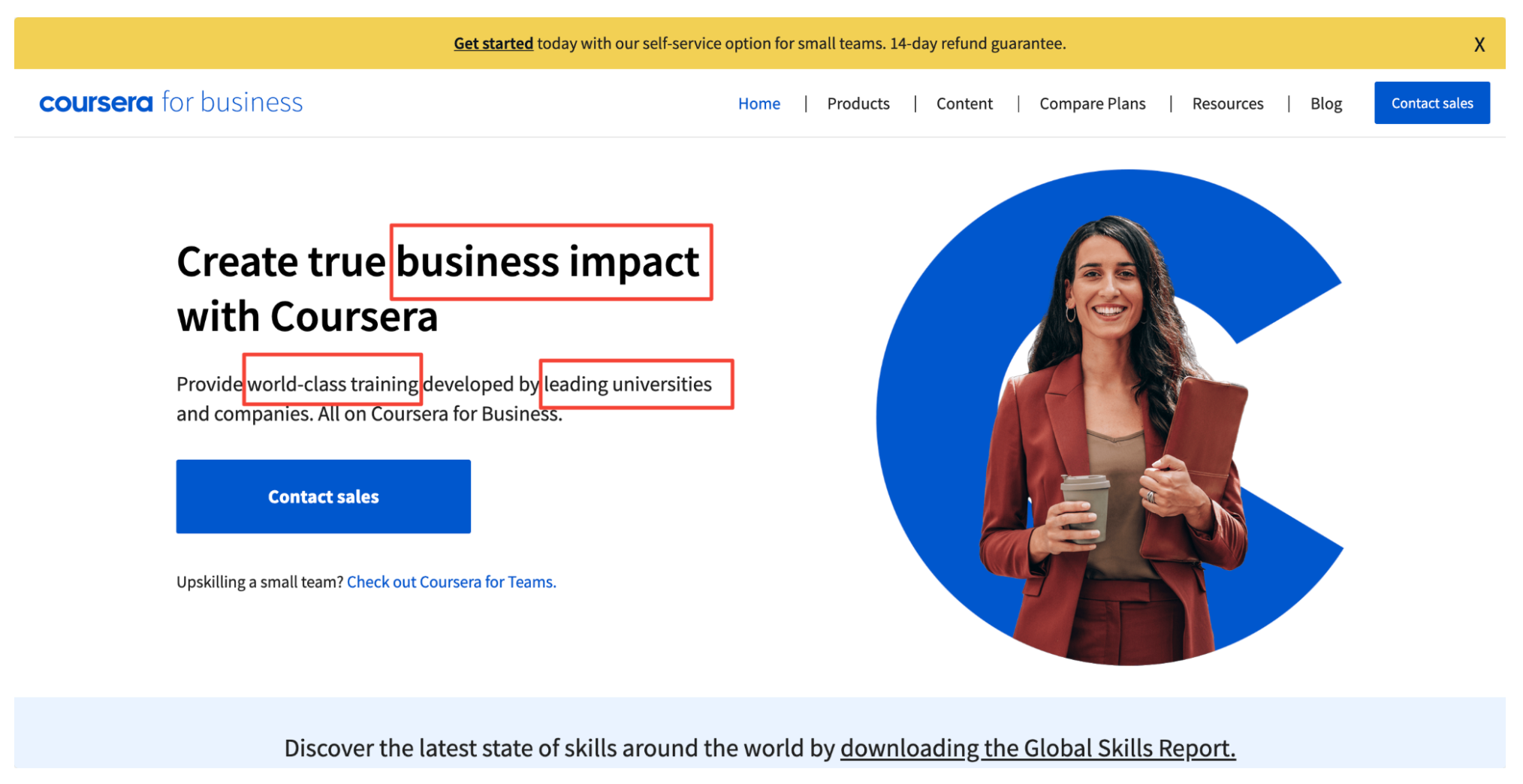
Here, Coursera focuses on “course ROI” messaging for corporate customers and speaks directly to decision-makers.
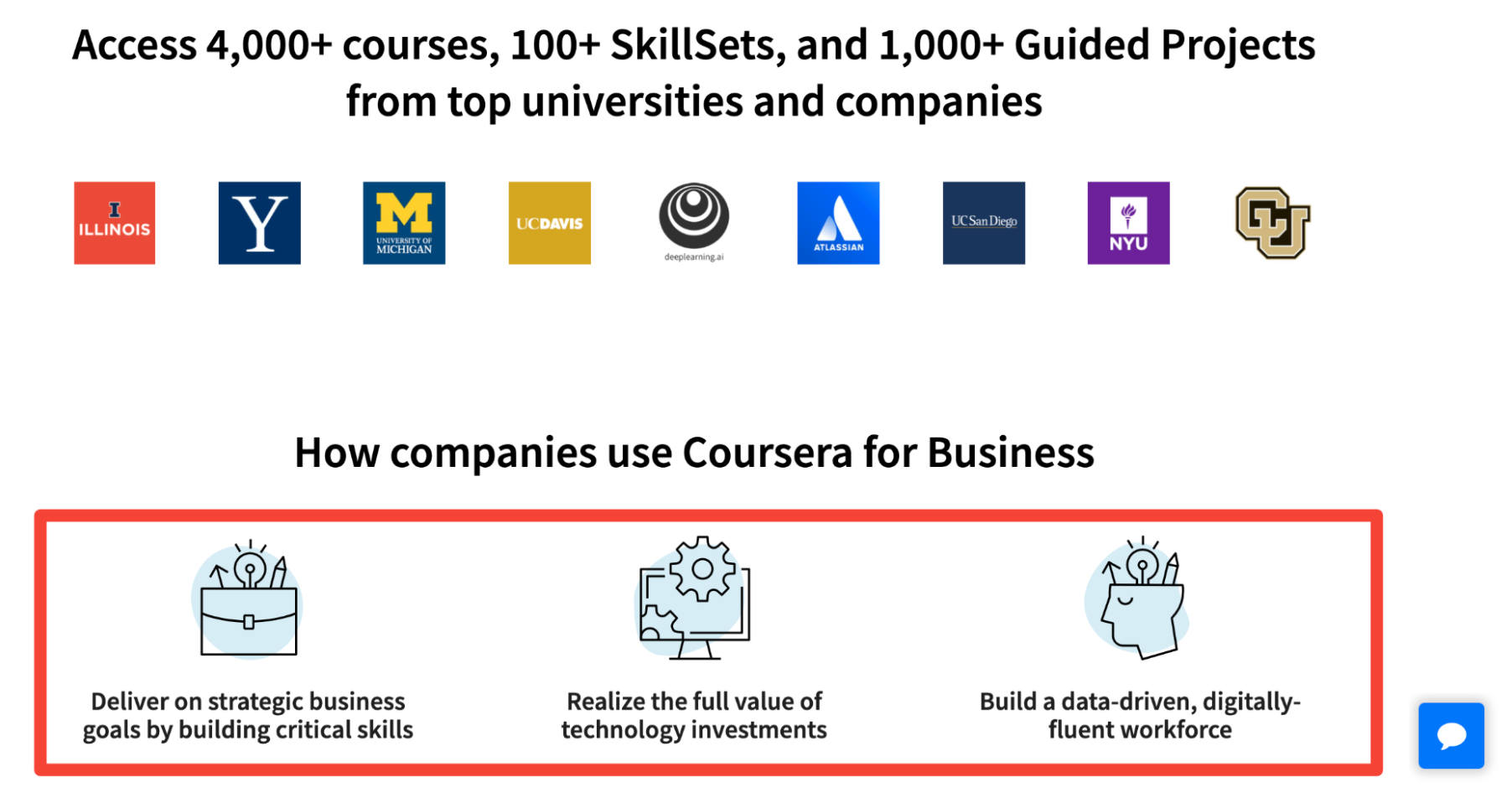
This business language is totally different from what you find in the B2C landing page where the objective is to offer free courses.
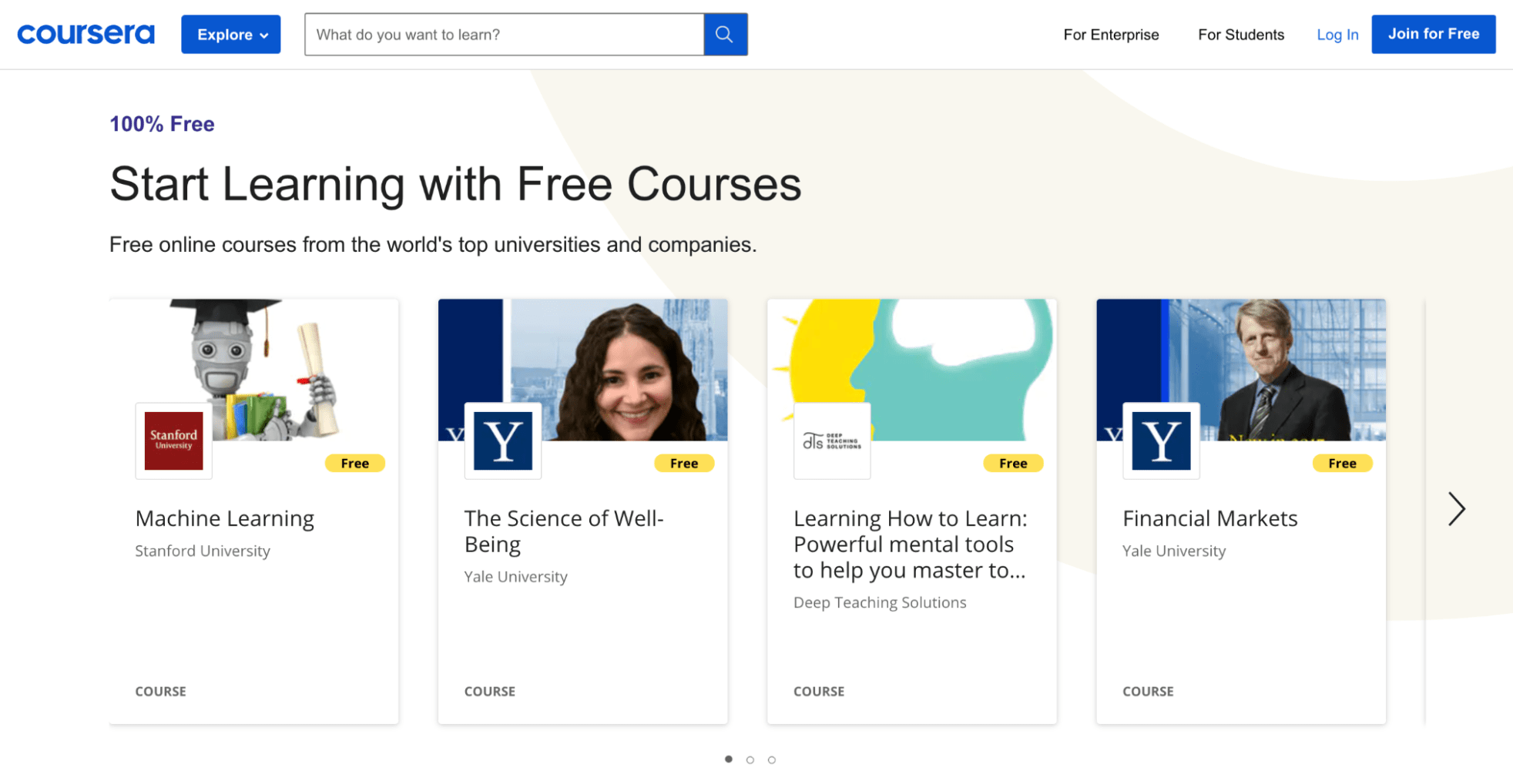
Part of the messaging in the B2B landing page makes it clear that companies can easily track the evolution of employees in the course and inform their status from a skills-building standpoint.
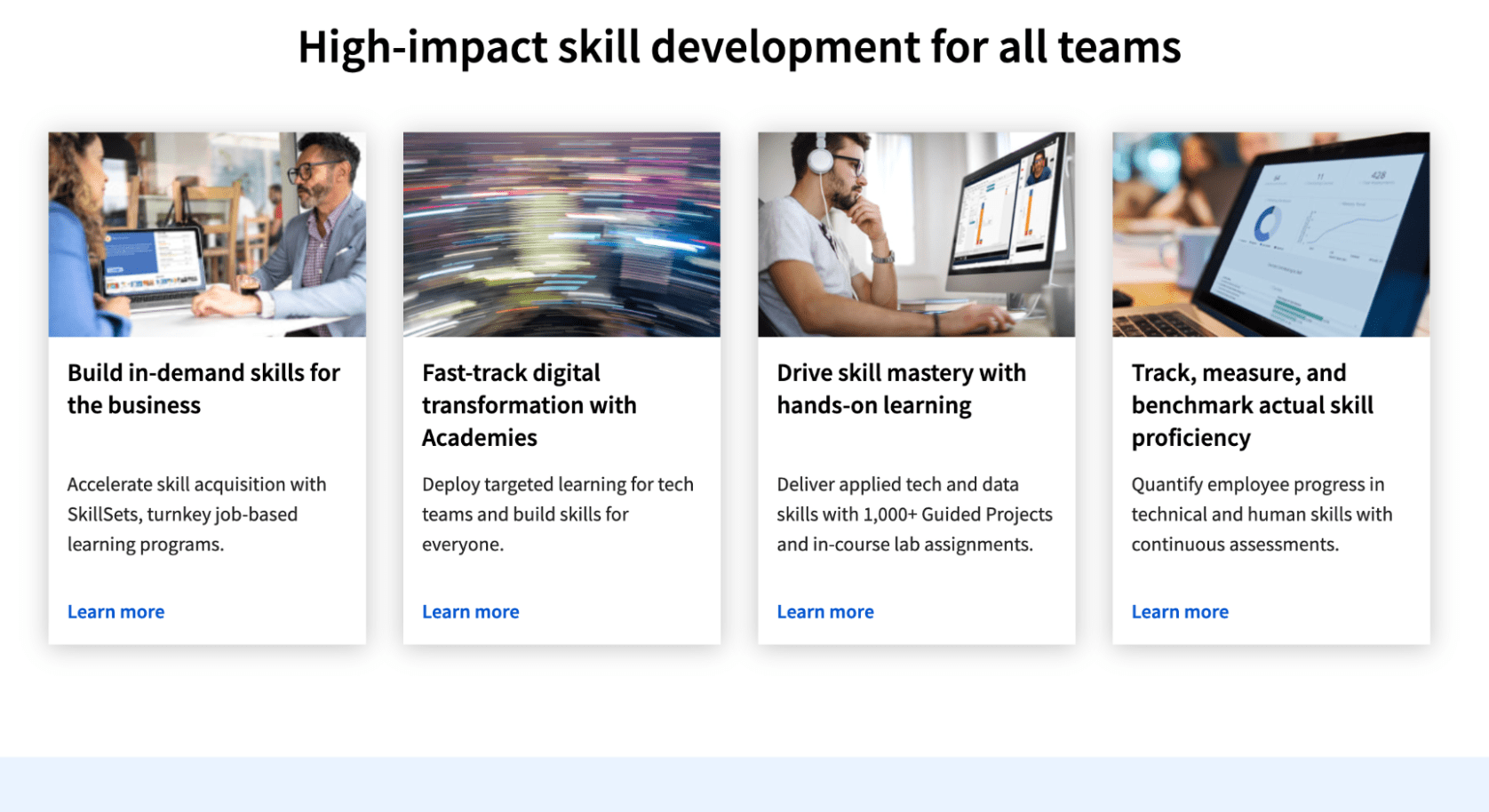
Why is this great?
First of all, the ROI messaging resonates directly with the B2B buyer. If you have to pay millions a year for a product or service, don’t you want to know the ROI?
Secondly, the language positions the courses not as conventional courses but as courses “run by the best universities in the world” and “taken by the biggest companies in the world.” This is exactly what someone who works at IBM or Oracle would look for when buying a high-ticket service.
And as you can see, this messaging is business-centric while in the B2C side, messaging targets individuals ranging from students to life-long learners. In fact, the B2C messaging is more in line with the “democratizing education” philosophy of Coursera.
Chatbots
You are probably wondering why someone would use a chatbot for a high ticket service?
The answer is, why not? In their state of conversational marketing report, Drift found that 55% of businesses that use chatbots generate more high-quality leads.
Coursera uses a chatbot on their website, so here is how it helps them grow their business.
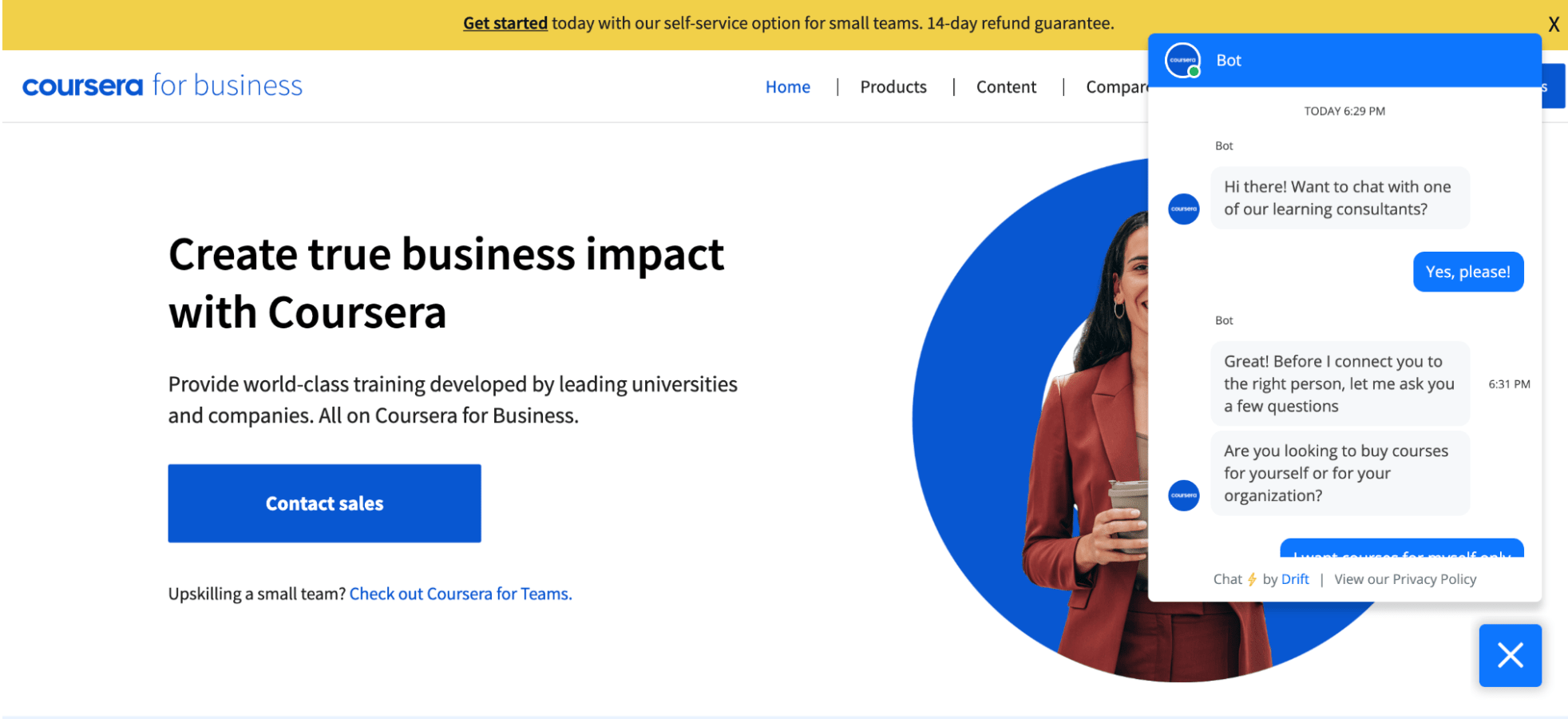
When you go to coursera.org/business, it only takes 10 seconds for the Drift bot to open the conversation, “Hi there! Want to chat with one of our learning consultants?”
Obviously, this bot is more about pre-qualifying leads than engaging them.
As such, most questions it asks have disqualifying options. When you go for “I’m looking for courses for myself,” the bot sends you a message saying you’re not a fit.
After these questions, the bot asks for your email. And at this stage, only business emails are accepted.
Still wondering how this helps Coursera close more B2B customers?
First of all, the chatbot makes it possible to identify high-value, high-intent contacts so that the sales team is empowered to deliver those prospects exceptional, personalized experiences.
Second, website visitors seem to have a much more engaging experience with chatbots.
Think about it. Assuming you want to book a sales call, isn’t it better to have some semblance of a conversation with an AI-powered conversational bot than to fill out a boring form?
Plus, the chatbot reduces friction from visitors who don’t like the idea of clicking on a button.
Want to Steal Coursera’s Segmenting Strategy? Download this checklist!
By downloading this resource, you’ll also start receiving a few emails per week on B2B growth and content marketing
Salespeople
You don’t buy a B2B product like you buy socks from Nike. It’s not a matter of ”click and buy.” It goes beyond that.
That’s why to sell B2B products and services; you need salespeople. In fact, it has been proven that in the B2B buying cycle, one-on-one interactions significantly influence purchase decisions.
On the Coursera for Business page, there is a Call-to-Action (CTA) that prompts visitors to contact a sales rep. Please note that this option is only available for prospects interested in the Enterprise plan. After all, big bucks deserve the biggest bang.
This strategy is several times more impactful than the one used in the B2C side. In fact, anyone can sign up for Coursera (for consumers) using any email address.
So, what are the steps of this onboarding?
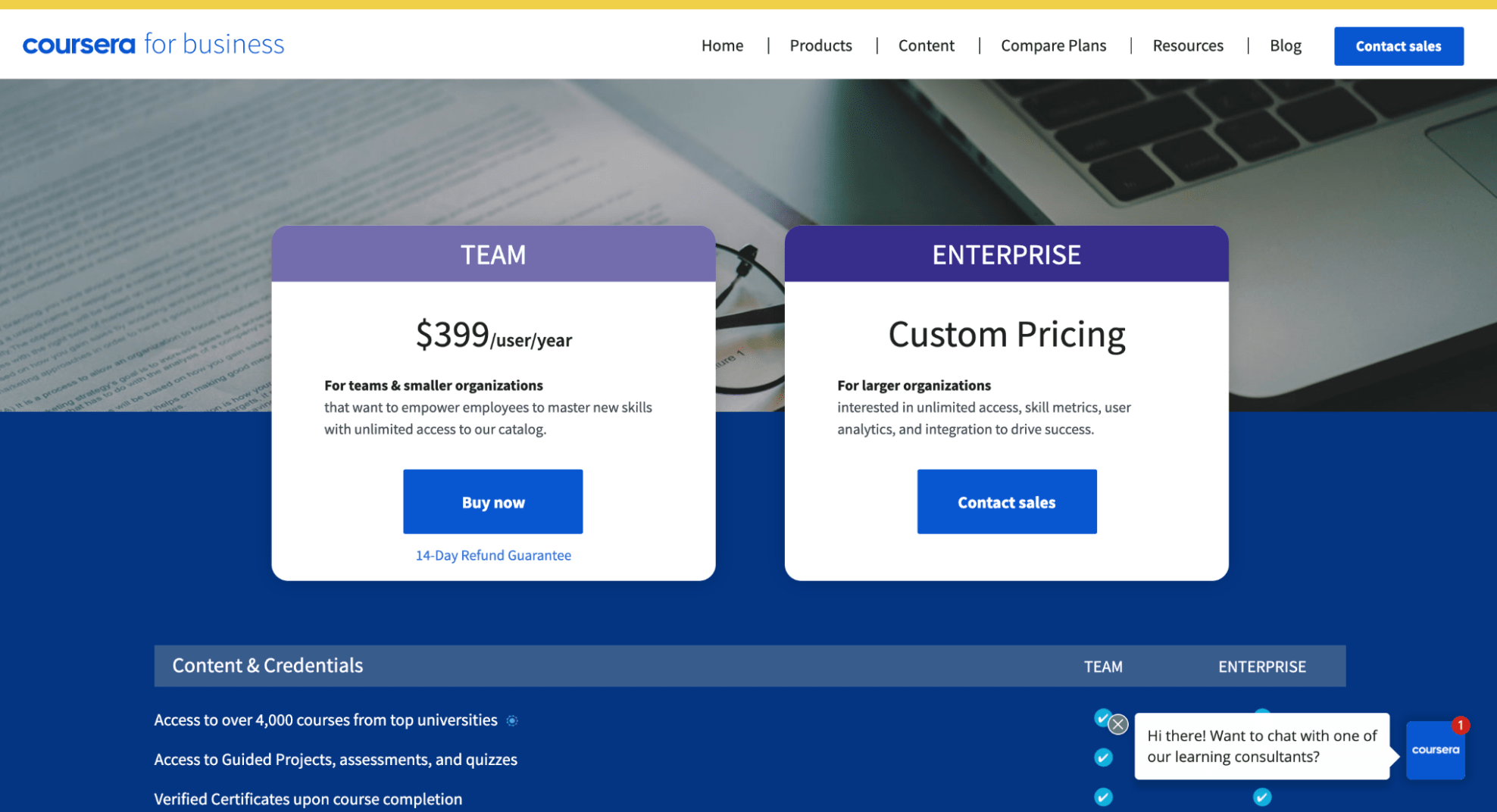
First, once you click on one of the CTAs, you are taken to another page where you are asked to fill out a form to get things started.
On this page, you will find a set of elements, such as logos of Coursera for Business clients and a client testimonial, which is meant to build social proof.
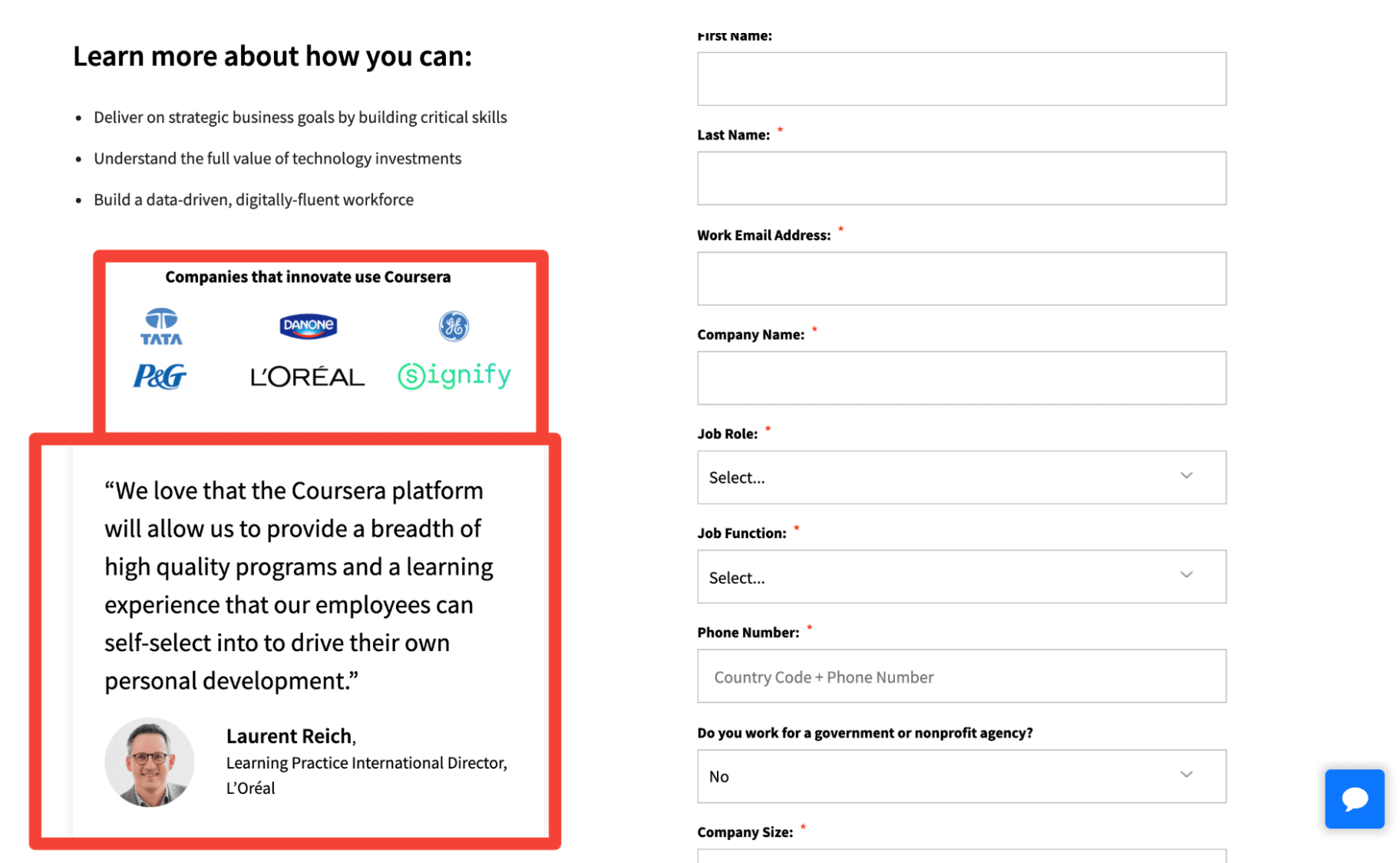
Next to it, you will see the form to fill in to be able to talk to a sales rep. And just like the chatbot, the form’s questions help the Coursera sales team identify your needs.
When you fill out the form, you are taken to the next page, which is a “Thank You” page.

A few seconds after filling out the form, you receive an email saying that a sales rep will contact you soon.
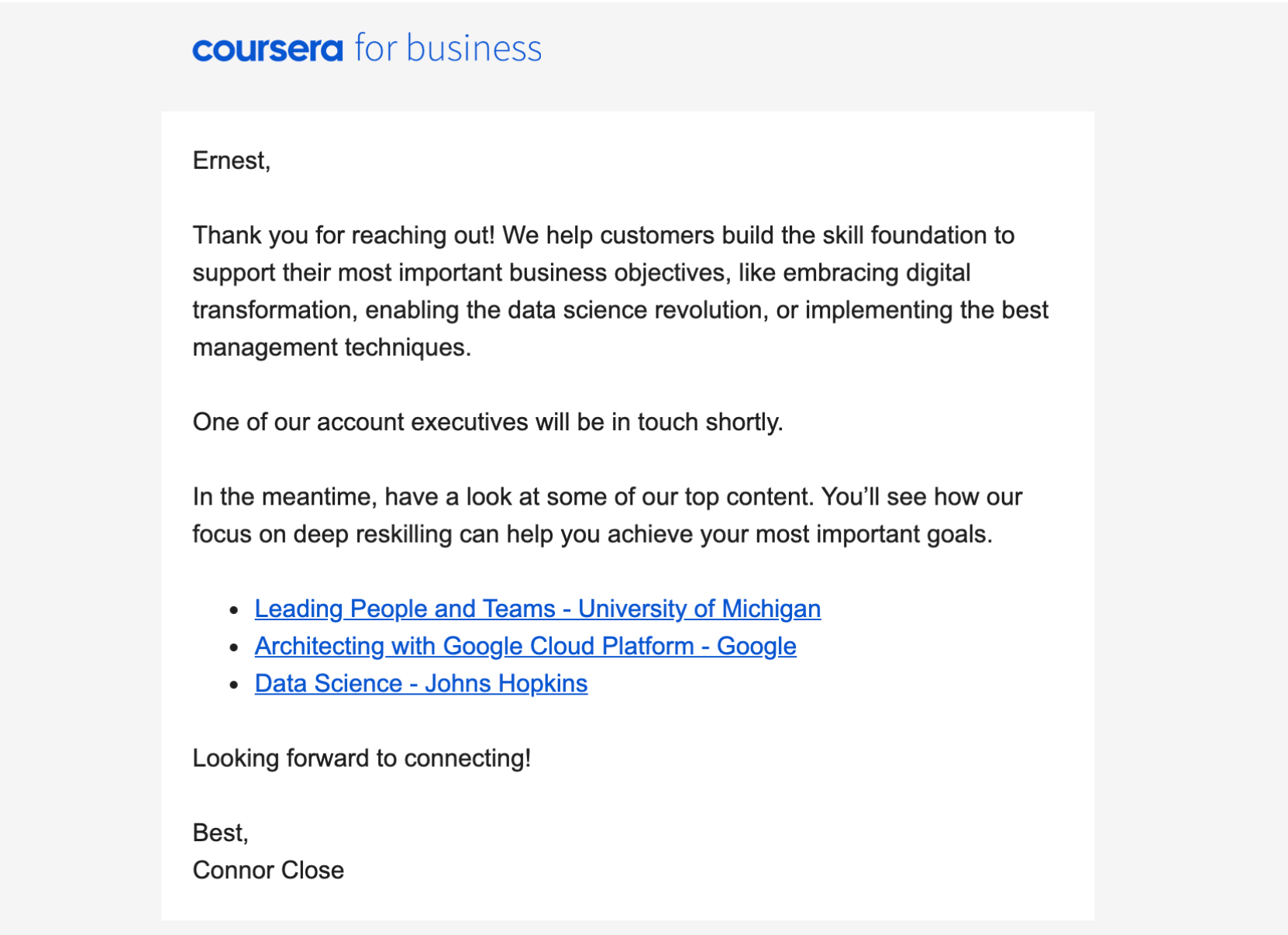
The “Thank You” page also contains a whole package of information that helps to inform prospects further and move them through the funnel.
Why is this effective?
Well, first of all, the process is seamless and very straightforward. The most significant benefit of having a headache-free sales process lies in the sales results.
Secondly, unlike other companies, Coursera does not overwhelm you with Calendly links to book a meeting. On the contrary, the process is smooth, engaging and leaves little room for aggressive sales.
Last but not least, the “Thank You” page contains the middle-of-the-funnel and bottom-of-the-funnel content that helps push a user deeper into the buying process.
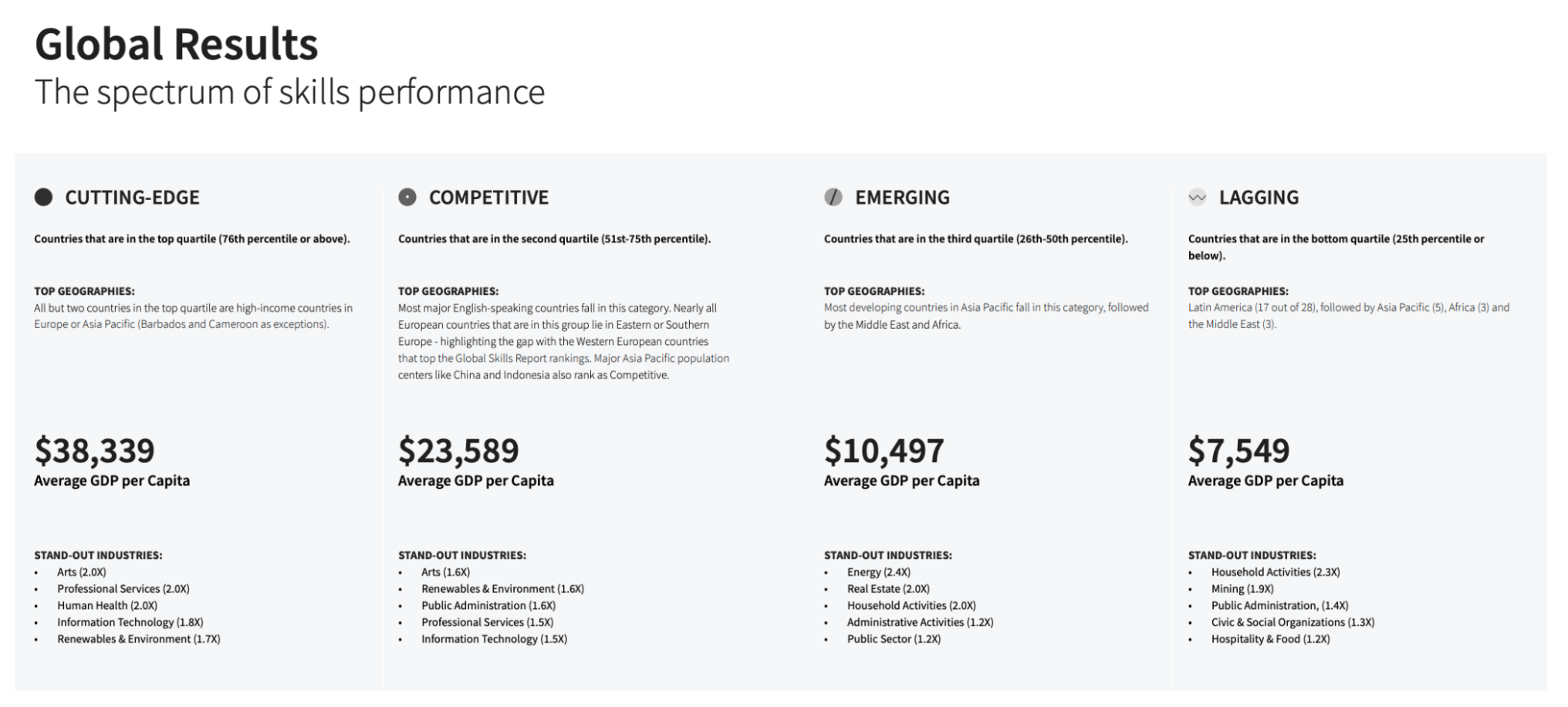
One such piece of content is the Global Skills Report that Coursera produces every year, which contains information on how companies can fill the skill gap in their workforce.
According to the company’s CEO, “The Global Skills Report aims to help governments and employers assess skill gaps in their workforce, identify roles that can be filled with diverse, non-traditional candidates, and details the specific skills that are needed for these roles.”
This report does a great job of boosting Coursera’s audience relations machine. But more importantly, it is an important lead generation asset that allows Coursera to drive business interest in Coursera for Business.
Reacting to customer demand
In addition to having a marketing arsenal that makes conversion smooth, Coursera also has a secret weapon: in-demand courses.
One could even argue that this is one of the things that sets Coursera apart from its competitors.
Let’s take a look at what in-demand courses are.
First, here’s what they are not. Coursera does not offer a la carte courses. So in-demand courses are not on-demand courses.
In-demand courses teach skills that give access to jobs that are in high demand. Coursera’s studies revealed that companies worldwide have a high demand for a certain number of skills like high-level analytics, machine learning, deep learning, and more.
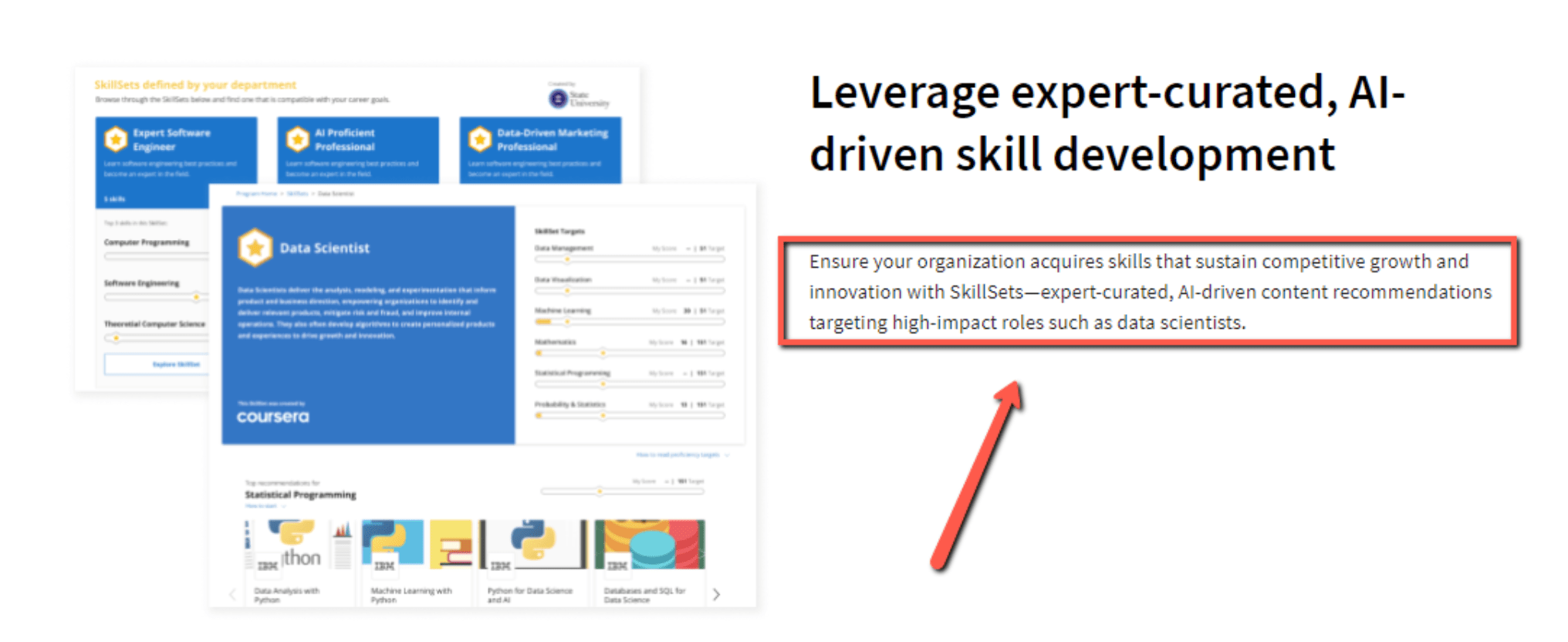
So instead of offering any course to anyone, Coursera revamped its platform and partnered with prestigious universities to provide these high-demand courses.
This has allowed Coursera to position itself as the go-to place for any company that wants to upskill its workforce on one or more of these new trends.
While much of Coursera’s success can be attributed to its business model, it is also important to recognize that this is not the only factor.
Coursera wages a ruthless SERP war against its competitors and the least we can say is that the payoff is huge.
Leveraging User Intent to Dominate SERP
Coursera also eats up most of its competitors on the SERP for searches related to group training or employee training.
The dedicated landing page for “Coursera for Business” generates 1.8 million traffic and ranks for 726K different keywords.

Although it is a thing, “team training” is still not so commonplace. Given that, these figures are enormous compared to what Coursera’s competitors get. Think of Coursera like the Don Corleone of training platforms for business.
See how edX for Business performs, for instance.

Of course, Coursera didn’t leave its competitors in the dust overnight. They did it by leveraging user intent to dominate the SERPs. They target different keywords that match every intent a visitor or searcher might have.
Check below how well the “coursera.org/business” page is doing on the SERP.

This is possible because Coursera for Business is optimized to rank for 1,419 organic keywords every month.
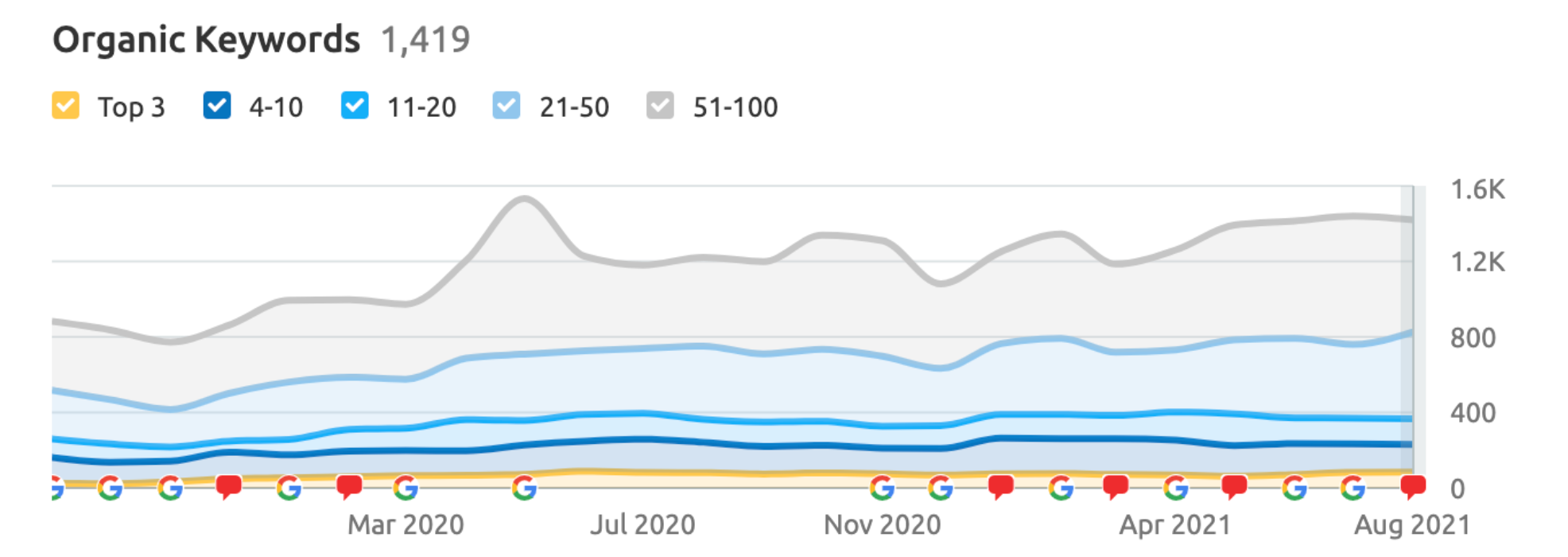
At the same time, the B2C side of the business is not lagging. It employs over 2.5 million organic keywords to attract free traffic through search engine optimization.
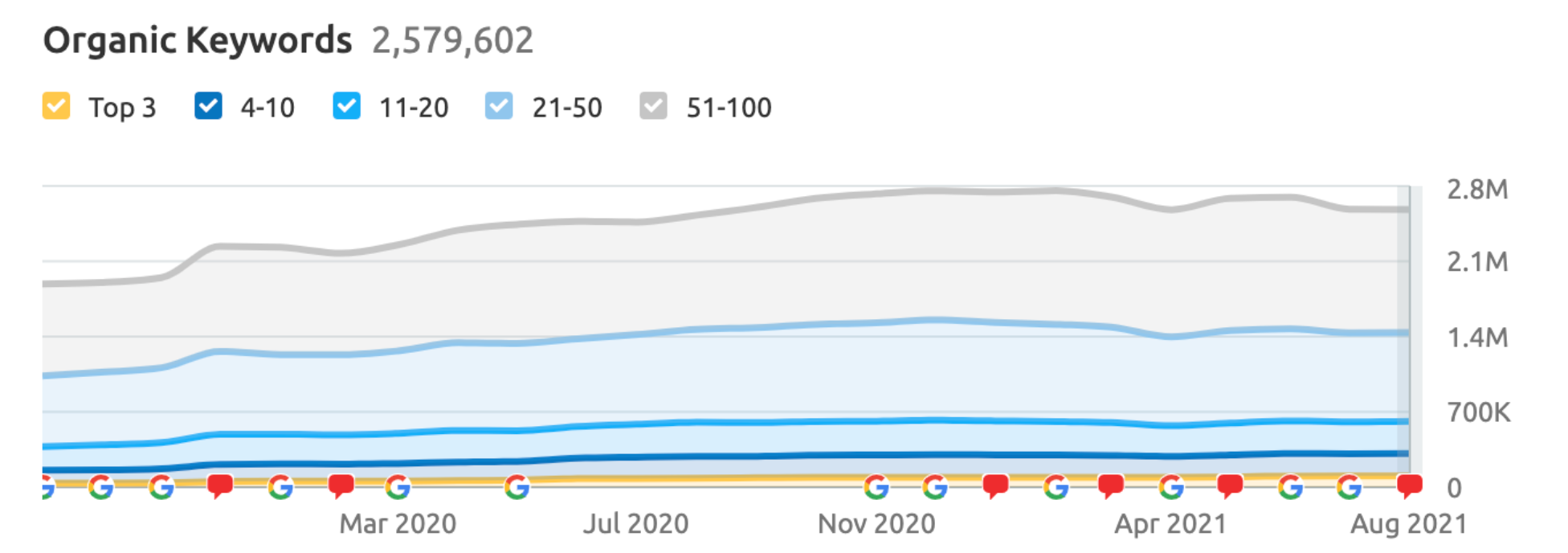
This is entirely understandable. Coursera’s goal here is to rank for any niche-related keyword. They do this brilliantly; they dominate the SERPs using those 2.5+ million organic keywords and ranking the top three for over 120,000 of them.
This allows them to attract individuals who fall within the B2B spectrum. For example, a business owner goes onto Coursera to take Chinese courses for his own culture. The latter may turn into a business customer in the long run.
But Coursera does not leave the fate of its “for Business” branch to luck. They also use more specific keywords to target business customers.
Targeting keywords to match corporate-level executives’ search intent
While the B2C side of the company focuses and targets direct online learning-related keywords, the B2B Coursera is subjected to a more sophisticated keyword targeting to meet high commanding enterprise clients.
As seen above, Coursera uses specific business language to address its corporate clients, and the keywords are no exception. Coursera understands that the people who read “coursera.org/business” are high-level professionals looking to achieve strategic business goals, or at least, they need the “big talk” before they buy. Thus, such is their written content, and such are the targeted keywords.
Allow me to quickly shed light on this by using the messaging on the landing page.
The B2B landing page:
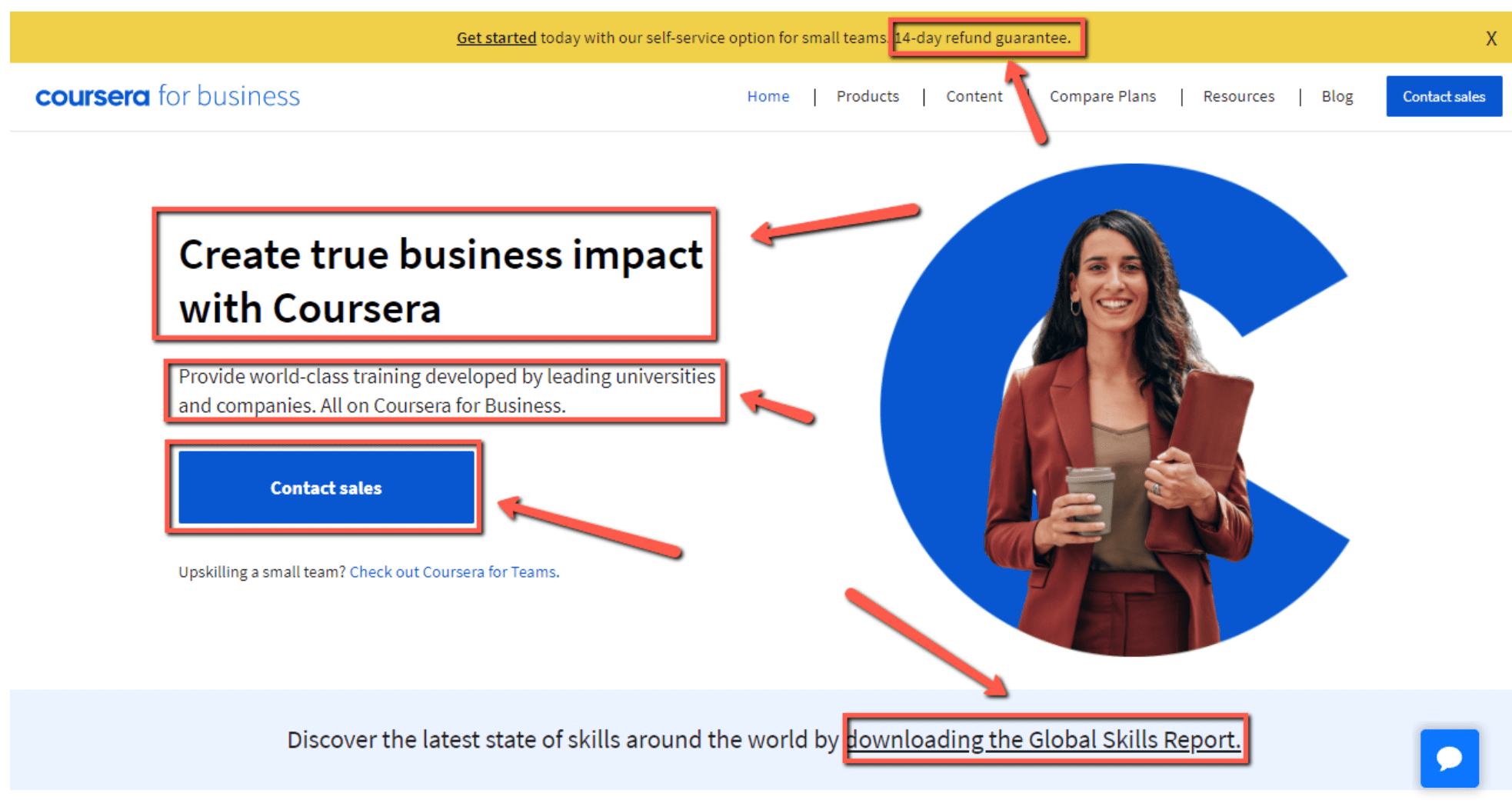
Let’s note the main corporate jargon-related words.
- “True business impact”
- “World-class training”
- “Global Skills Report”
- “14-day refund guarantee”
Scroll down, and you see more of this targeted messaging.
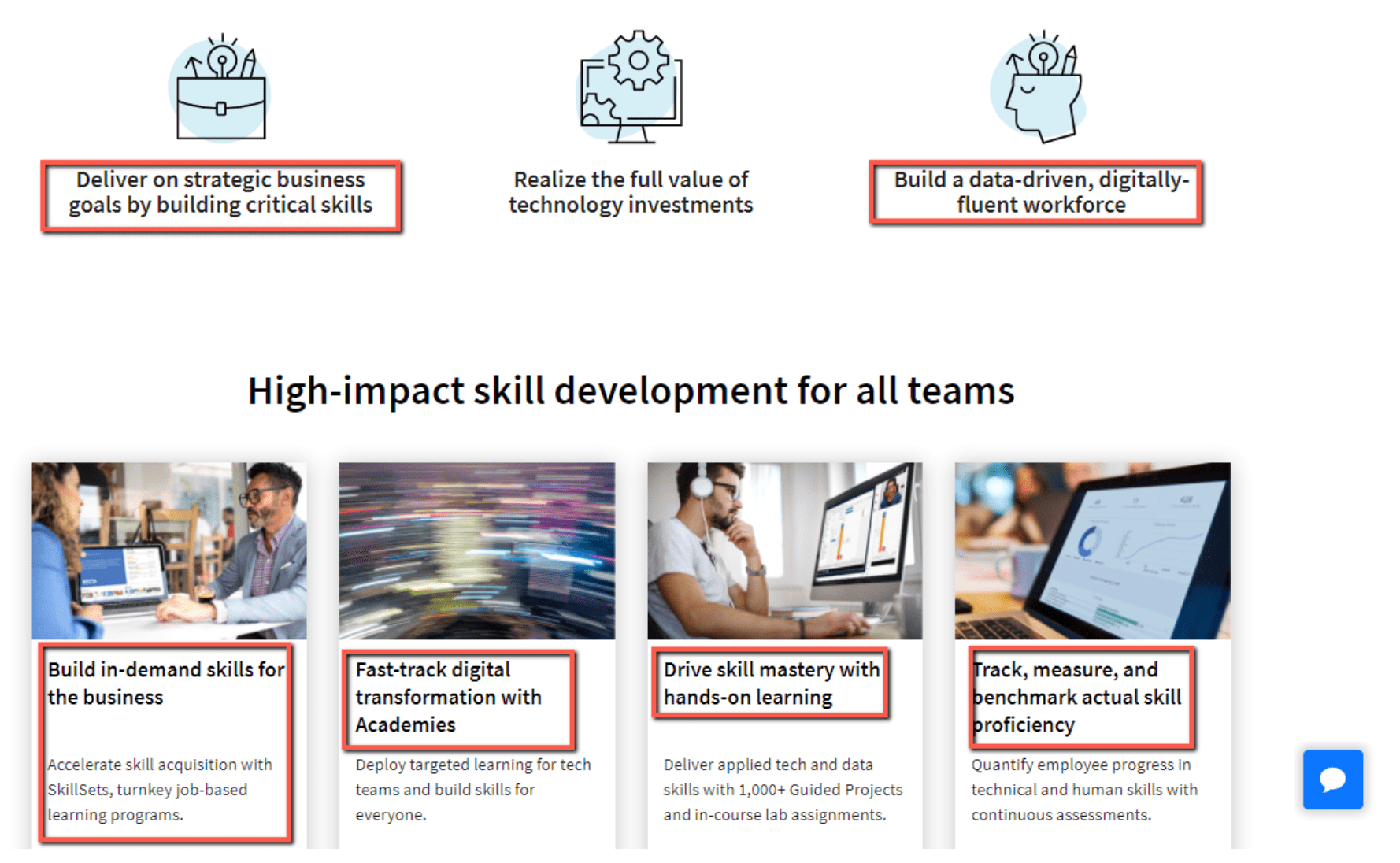
- “Building critical skills.”
- “Digitally-fluent workforce”
- “Turnkey job-based learning programs”
- “Skill mastery with hands-on learning”
The use of these words is no coincidence. Coursera knows that this language will win over corporate-level executives. The average person would just like to “learn without limits.”
Corporate executives understand a specific language, have goals, and need to track ROI. That’s why Coursera’s messaging is based on that intent. And these are the keywords that Coursera uses to lure them to its website.
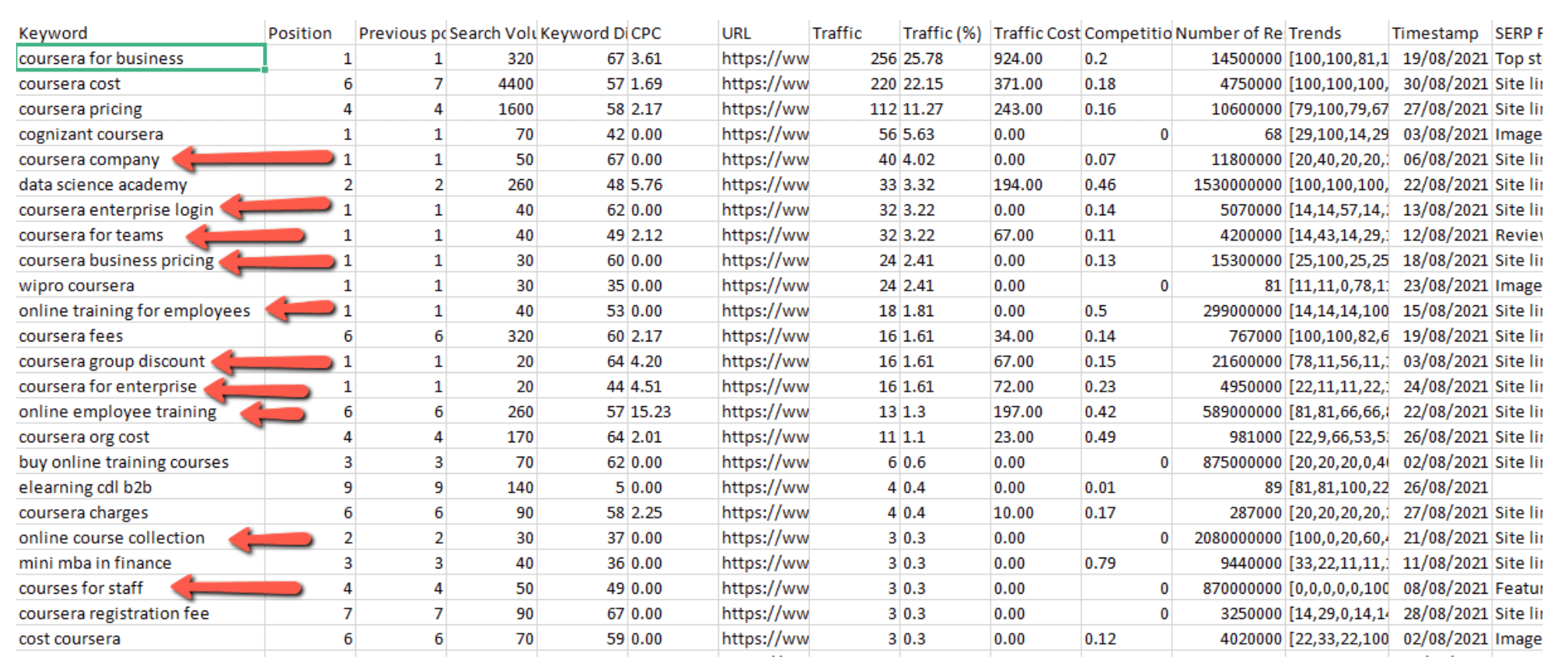
- “Employee training”
- “Coursera for employers”
- “Coursera for enterprise”
- “Training for employees.”
A corporate executive will not look for keywords like “data science” or “learn graphic design.” By designing specific keywords for the B2B audience, Coursera delivers on the intent of the searcher. And those particular keywords help match the Coursera B2B landing page with their search intent right off the bat.
Wrap-up
Coursera has built a solid reputation with what was known as a not-so-lucrative business model in a complex industry. Monetizing their platform is the biggest challenge any MOOC company can face in its early days. We now know that B2B business models (coupled with the B2C branch) and SEO techniques were definitely the cornerstones of Coursera’s success.
Let’s wrap up what Coursera has done over the years to grow into the MOOC giant it is today.
- Balancing two business models for a single purpose
The adoption of the B2B business model has enabled Coursera to rise to prominence over most of its competing companies. They have gained a unique angle to sell their services, and, as a result, they’ve achieved a consistent revenue stream.
Most significantly, they have balanced the B2B model with the existing B2C model. The B2B activity generates huge revenues, and the B2C drives high traffic, which is how Coursera is able to achieve great success.
- Using messaging their customers relate to
Part of balancing two business audiences is speaking a language that each audience can understand. Coursera does a great job of using different messaging to appeal to each audience.
The Coursera for Business page, for example, is aimed at people with decision-making power. These people speak a different business language, and the landing page messaging is designed to meet that standard.
- Offering tailored training services on demand
Offering practical on-demand courses to companies to improve the skills of their staff has been one of the most effective ways for Coursera to secure its multi-million-dollar annual revenues. Coursera not only sells courses, but also helps companies train their staff to meet specific objectives. Companies can measure their ROI by hitting on their goals.
- Using SEO to win the market
Coursera has one of the most effective SEO empires in the MOOC industry. The company outperforms most of its competitors with its unique and unparalleled approach to SEO.
Coursera relies on user intent to create automated, keyword-optimized pages for its courses to stay on top of the SERPs. The B2B version of their service gives the company a unique edge over even the most successful competitors. The B2B landing page alone has potential traffic of 1.8 million visitors.







